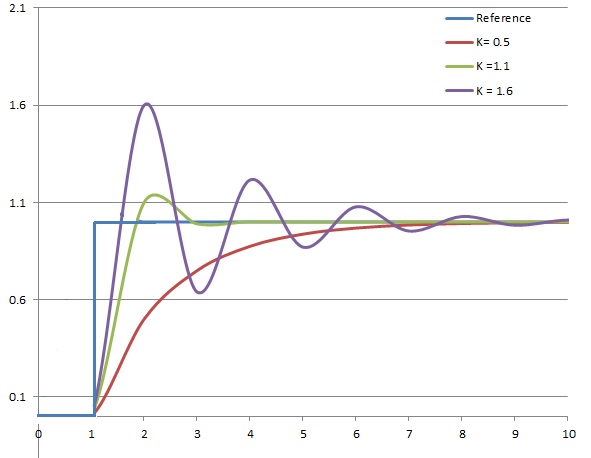Alicat flow and pressure controllers use closed loop control algorithms to achieve their highest degree of control stability. The algorithms are a mathematical relationship that dictates the response of the valve to the flow or pressure conditions. It assesses the difference between the set point and the process value—whether it be mass flow, volumetric flow, or pressure—as an error. The degree of error determines what kind of input to send to the valve, reaching the correct value in the quickest time possible. The amount of time expended to minimize the error—and therefore the control response of the controller—depends on what type of loop is being used (PD or PD2I) and what P, D and I values are used.
When you order your controller, we set the Proportional and Derivative values by trying to replicate the application parameters (process conditions) to the best of our ability before we ship it to you. This customization to your system is one reason our controllers are fast.
No worries
If process conditions change, the valve response may change drastically depending on how much you deviate from the conditions the valve was tuned at. You need not worry about erratic response from your controller if the conditions change, since PID tuning can be done in field to get better control at the new process conditions. You can change PID terms through the display panel buttons, or through electronic commands using digital or analog communications.
You’ll get optimal performance from your controller when you select correct values for all three parameters (two in case of single valve controllers). The ‘P’ term opens the valve to achieve the set point, ‘D’ term applies a damping influence to eliminate the overshoot and ‘I’ function helps the system settle to the set point.
Oscillating around the set point
If your controller shows signs of oscillations about the set point, or is unstable in its control response, it is a sign that the P term is too large. The greater the P value, the greater the range of oscillation. To get rid of the oscillation (settle the controller to set point), you would need to decrease the P term.
Let’s say you have a 10 SLPM controller set to 10 SLPM for Hydrogen. The controller is oscillating between 8 and 12 SLPM. Hydrogen is a low viscosity and a very light gas compared to Air. This being the case, the valve—which is tuned with air—should be re-tuned. So, starting with the factory P value (for example, it may be 1000), try decrements of 10% and keep on going down until you see the controller settle to the set point quickest. Generally, we only touch the D terms after you have altered the P term, so if you still have small oscillations, you can increase the D value with 5-10% increment. This should help the controller become more stable.

Excessive P (purple) produces oscillation. Low P (red) slowly rises to the setpoint. Optimal (green) settles quickly.
Delayed setpoint
A second situation is when your controller takes too long to get to the set point or never achieves the set point, but settles to a flow rate or pressure below the set point value. This implies either too small a P value being used or too large a damping influence. Using the analogy of a car, imagine you want to get to 70 miles per hour. but when you start increasing the speed, someone applies brakes which decreases the acceleration of the car. The car may never get to 70 mph if the deceleration is larger than acceleration, and the car may settle at a speed of 60 mph when acceleration = deceleration, or the opposite forces are equal.
In this case, try increasing your P value in 10-15% increments until you see the controller getting close to your set point. Next step would be to decrease the D value to help the controller get to the set point in a quicker time. If you start seeing some oscillations, that means the D value has been set too low.
Control loop adjustment is all about getting a good feel of how the controller responds to changes in the P and D terms. The gas viscosity, inlet pressure, back pressure can greatly influence how the valve responds. Tuning the valve is an art rather than science and the more familiar you get with your controller, the better you’ll be able to tune it.
Alicat promises lifetime customer support over the phone, so if you feel more comfortable with us helping you out with tuning, give us a call at 520-290-6060 and we’ll be more than happy to assist you.


















